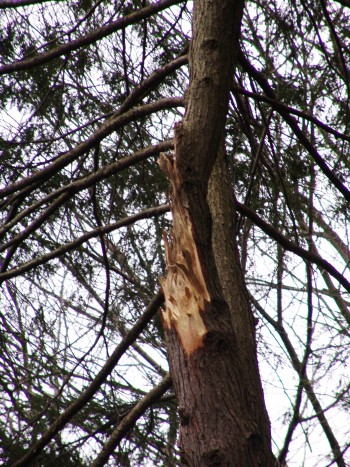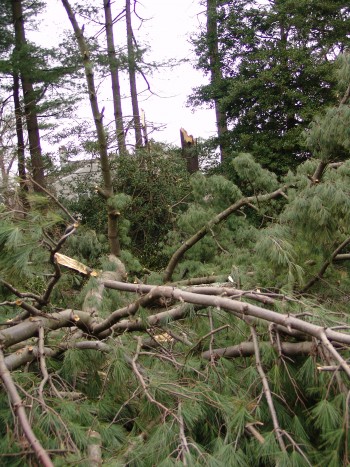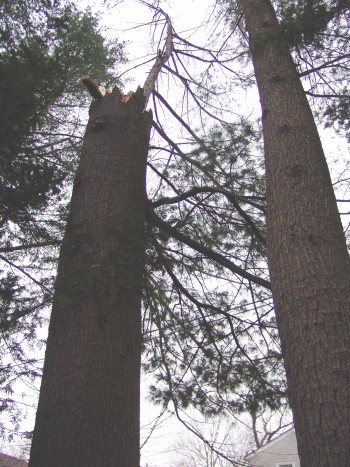5 Ways to Prevent Wind Damage
While the staff of the Scott Arboretum was on break over the holidays, Old Man Winter was blowing his hardest across the grounds of the Arboretum. His huffing and puffing caused two white pines and a hemlock to come crashing down and take neighboring plant limbs along for the ride. It is not unusual for the dry winter wind to cause damage in the garden. As gardeners, most of the time we at the mercy of Mother Nature and Old Man Winter, but there are some steps you can take to prevent and/or mitigate wind damage in your garden.
1. Use proper pruning techniques.
Pruning can correct problems or create problems. Some good pruning techniques include: removing branches that cross over or rub against one another, any side branch that is taller than a main stem, narrow crotches, and dead or broken branches.

This hemlock split in high winds because of a double leader created a weak crotch in plant's structure. photo credit: R. Robert
As you can see from this image, the hemlock which split behind Willets Hall had a double leader creating a narrow, weak crotch where the tree eventually snapped.
2. Maintain a healthy tree.
Control insects and diseases on your trees. These menaces weaken trees making them more susceptible to other types of damage.
3. Avoid injury to trunks and roots.
Create a mulch bed around your trees while keeping the root flare exposed to prevent the lawn mower from damaging the trunk. Create paths around tree roots, not over, to avoid compaction and root damage.
4. Plant wind-resistant, appropriately-sized tree species.
Coniferous evergreens are the most susceptible trees to wind damage as exemplified in the damage the Arboretum experienced over the holiday. London plane tree, Platanus xaceriflolia, and sycamore, Platanus occidentalis are wonderful wind-resistant trees. Our curator, Andrew Bunting, noted that he has never seen either of these trees damaged by wind. Any tree with a tap root does well in the face a wind storm. Other suggestions include: beech (Fagus), sour gum (Nyssa), oak (Quercus), hickory (Carya), and ginkgo.
5. Plant your tree properly.
Remove any girdling roots before planting, otherwise stem compression will weaken the tree. Plant the tree at the proper depth, the root flare should be visible. Trees with shallow roots systems do not grow enough of a root system to anchor the trunk and branches thus resulting in high winds blowing over the tree.
I hope these tips will help your garden survive the chill of Old Man Winter.







Joe Walker
Posted at 17:54h, 06 JanuarySo then, will today’s slight wind enhance the protective barrier contained in the mild rain storm? Unless the rain freezes and that ice wieghs down the branches until they splinter and break.
Can I purchase either some post-season white pine or hemlock garlands? Or else you have some mulch ready to go when it’s time to mow this spring.